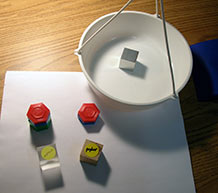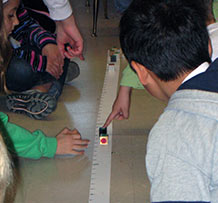How much do the cubes weigh in grams?
Plan Investigating Standard Measures 2
Students have been thinking about the cubes and their relative weights for a while. In this investigation, they see those relationships expressed in grams. While the activity is simple — just weigh and compare — students’ thinking about weight becomes more sophisticated.
Formative Assessment
Available online at inquiryproject.terc.edu
Students weigh the cubes in grams and place them on the weight line. As they study the array, they focus on two embedded ideas: the additive nature of weight and the continuous nature of weight. They also have another opportunity to ponder why these same–sized cubes have such different weights.
By the end of the investigation, students will be able to describe more explicitly how the weight of one cube compares to another.
Learning Goals
- to determine the gram weight of the materials cubes
- to use a weight line to compare the weights of objects
- to consider the additive nature of weight
- to appreciate the continuous nature of weights
| Sequence of experiences | ||
|---|---|---|
| 1. Ask the question | All Class | 5 Mins |
| 2. Weigh the cubes in grams | Small Groups | 15 Mins |
| 3. Add the cubes to the weight line | All Class | 5 Mins |
| 4. Make meaning | All Class | 15 Mins |
Materials and Preparation
For the class:- Post the investigation question in a place where all students can see it.
- Make a class table on a whiteboard or flip chart for recording the gram weights of the cubes; an example is shown in Step 2.
- the plastic weight line
- 1 index card labeled “Grams”
- 2 or more sets of materials cubes (each student needs one cube to weigh)
- 2 cubes that have been cut in half
- 1 gram weight set
- 2 pan balances
Notebook Pages
Do students know the weights of the 8 cubes in grams? Do they understand why they'll use grams as the standard unit of weight?
Look at notebook entries to find evidence that the student has an accurate record of the weight of each cube in grams. You'll also find evidence of their understanding of the rationale for using grams to weigh things.
Use these criteria to interpret student work:
- The cubes should weigh approximately:
Pine 7g, Oak 13g, Nylon 18g, Acrylic 19g, PVC 22, Aluminum 44g, Steel 128g and Copper 147g. Humidity will affect the weights of pine and oak, and the (in)accuracy of the balances may cause the measurements of all cubes to vary by one or two grams. - Rationales for using grams:
this is the unit used by scientists around the world, like paper clips, they are light enough to discriminate between objects that are very close in weight.
Next steps might include selecting another small object, estimating its weight in grams, and weighing it.
1. Ask the question

Show students a set of materials cubes and tell them they will weigh the cubes in grams, just as they weighed the classroom objects. Remind students that grams are the units scientists use.
This will be the students’ first opportunity to discover how the weights of the cubes compare in terms of grams. Point students’ attention to the investigation question:
Let students know that more than one student will weigh each type of cube. Scientists want other scientists to try the same measurement or experiment, to see if they get the same result. This is one way that scientists learn if their work is accurate, or if they have made a mistake.
- Why do scientists want other scientists to try the same measurement or experiment?
Give every student one cube to weigh. As you hand each student a cube, ask them to think about or predict how much their cube weighs in grams.
2. Measure and record the gram weights
Students work in small groups to weigh their cubes and record the weight in grams in their science notebooks. As they finish, students enter their results in the class table.
| Cube Material | Weight #1 (grams) | Weight #2 (grams) | Weight #3 (grams) | Final Weight (grams) |
|---|---|---|---|---|
| Pine | ||||
| Oak | ||||
| Nylon | ||||
| Acrylic | ||||
| PVC | ||||
| Aluminum | ||||
| Steel | ||||
| Copper |
Table Note: Classes with more than 16 students will need part of a third set of cubes in order for every student to weigh a cube. Classes with more than 24 students will need a forth column.
Note: See the Science Background for more information about the cube weights.
Review the results in the class table. If cubes of the same type have weight differences of a full gram or more, ask students to swap the cubes in question and weigh them one more time. Finally, have students record in their science notebooks the agreed-upon “Final Weight” of the full set of cubes.
3. Add the cubes to the weight line

Have students gather at the weight line with their cubes, and draw attention to the unit label: “Grams.” Invite one or two students at a time to place their cubes on the line, taking their weight data from the class table or from their notebooks. Allow multiple cubes of the same material on the weight line to give everyone a sense of completion for this part of the work.
4. Make meaning
Purpose of the discussion
The purpose of this discussion is to bring forward the idea that weight is a property that can be increased in small or large increments.
Students can see just “how much heavier” some cubes are than others; they can even express the weight differences with some precision.
Engage students in the focus question
How much weight do I have to add to cube A to make it the same weight as cube B?
Draw students’ attention to the weight difference between pairs of cubes by asking a series of questions cast in this form:
- How much weight do I need to add to cube A to make it the same weight as cube B?
This is a different way of asking the question, “How much heavier … ?” It avoids focusing attention on the individual weights of the cubes and instead highlights the size of the difference between them. It also emphasizes the additive nature of weight. Start by asking students about cubes that are fairly close together:
- How much would I have to add to the acrylic cube to make it weigh the same as the PVC cube?
[about 3 grams] - How much would I have to add to the pine cube to make it weigh the same as the oak cube?
[about 6 grams]
Detours: Seeing the cubes arrayed on the weight line, students may again wonder how it is possible that objects of the same size can have such different weights. Some students may again think that the cubes are hollow or filled with some unseen material. Assure them that every cube is solid and made of the same material all the way through. Back up the claim by showing them the cubes that have been cut in half.
Continue asking about pairs of cubes until the students seem to grasp that weight is a property that can be increased in small and large increments.
A Thought Experiment:
To foster understanding of the continuous nature of the weight line, ask students to imagine cubes made of other materials, and to say where those cubes might fit on the weight line. Consider all suggestions, both serious (e.g., a cube made of glass or brick) and more frivolous (e.g., a cube of banana, or ice cream, or cotton candy). Ask students to defend their suggested locations and to “guesstimate” the weights of their imaginary cubes in grams. By the end of the exercise, students should be clearer that every point on the weight line represents a different weight; that there are no gaps; and that a new object can be added between any two points on the line.
As you end the session, tell students that they can continue to think about and write down even more ideas for cubes that they could add to the line. Students may also reflect on the following question:
- Why use grams?







